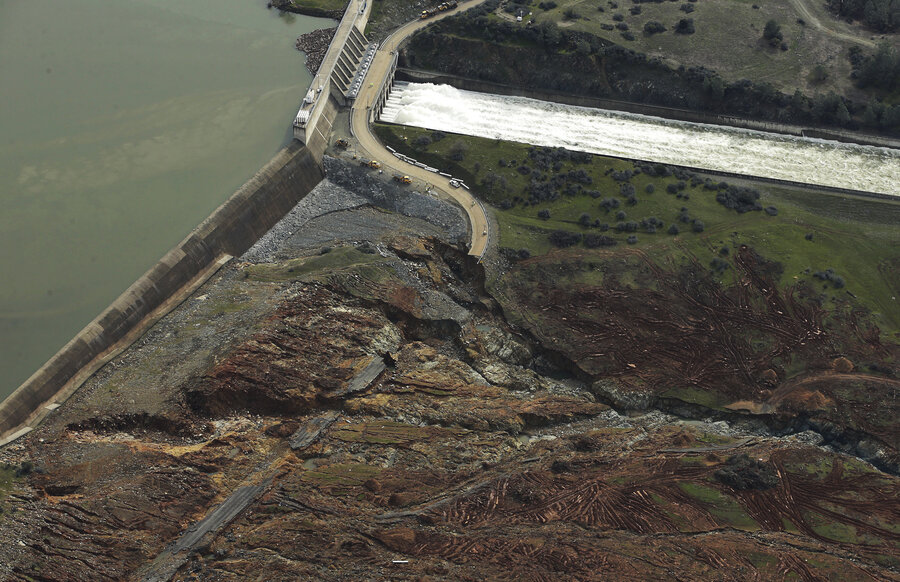Is there a lesson in problems at the Oroville Dam?
Loading...
Things got scary downstream of the Oroville Dam this week. And with new storms brewing in northern California, nearly 200,000 evacuees are still holding their breath.
Municipal crews worked round-the-clock Tuesday to stave off potential disaster. Engineers kept water from Lake Oroville gushing out through a spillway, bringing the lake’s levels well down from where they peaked on Saturday, according to the Los Angeles. And workers raced to patch up a second, emergency spillway that, like the first, was damaged over the weekend, threatening to unleash floodwaters on the region.
With the initial scare hardly past, however, scrutiny of the damage to the spillways has raised questions about what lessons might be gleaned from a still-precarious situation – or whether the Oroville Dam’s spillway problems were a freak accident, a matter of poor planning by regulators at a single site, or something else.
“I don’t think we know what went wrong, frankly,” says Marty McCann, a Stanford University civil engineer and director of the National Performance of Dams Program. “I would expect that there would be any number of boards that would investigate this.”
“But people are focusing on the emergency spillway,” he adds, “and rightfully so.”
In the dam’s 50 years in existence, that spillway had rarely been necessary. But after the main channel for diverting excess water during major rain events was damaged, California Department of Water Resource (DWR) engineers redirected waters toward the second, suddenly putting it to the test.
The sturdiness of that spillway – little more than a concrete weir that channels water down a dirt hillside – had been called question over a decade ago by environmental groups, during the dam’s re-licensing.
In 2005, three groups filed a motion that asked federal regulators to require California to reinforce the hillside with concrete, warning that floodwaters could erode it and send rocks, soil, and debris into the Feather River below, causing damage and threatening lives downstream, reported the Oroville Mercury Register.
“We said, ‘Are you really sure that running all this water over the emergency spillway won’t cause the spillway to fail?’ ” Ron Stork, policy director with the Sacramento-base Friends of the River, told the paper. “They tried to be as evasive as possible. It would have cost money to build a proper concrete spillway.”
Regulators determined that the extra “armor” wasn’t necessary, with one senior engineer at the Federal Energy Regulatory Commission pointing to guidelines specifying that “during a rare flood event, it is acceptable for the emergency spillway to sustain significant damage,” according to The Washington Post.
The damage incurred over the weekend, however, appeared to have crossed the line from significant to potentially dangerous.
On Sunday, monitoring officials reported severe erosion on that spillway, even though water volumes were just 3 percent of what it was supposed to be able to handle, and triggered the mass evacuation.
That was a worrisome surprise, says Dr. McCann.
“That just shouldn’t happen,” he tells The Christian Science Monitor.
Others have wondered whether the problems might be traced to infrastructure woes. As The Atlantic noted on Monday, the American Society of Civil Engineers gave the United States a “D” grade in 2013 for maintenance of its aging dam networks, most of which were built in the 1960s or earlier. But dam safety in California is also known to be as among the country’s most robust.
Still, dams can be notoriously difficult to maintain, as large volumes of water can sometimes behave in unpredictable ways, says Gregory Baecher, a civil engineer at the University of Maryland and dam safety expert. The kind of erosion on the main spillway is particularly common.
“That’s something we see a lot in dams,” he tells the Monitor.
Whether the issues on the main spillway were due to aging, inadequate maintenance, or something else remains unclear, he notes. And the Oroville Dam is often seen as the “poster child” for California’s water-project excellence.
But “this is a thing that dam-safety and hydraulic engineers worry about all the time,” he says. “The forces of water are just huge.”
“The bill from lack of maintenance over the last 50 years is huge,” he tells the Monitor.
“I think this does point out that we have to keep investing in maintenance of all this stuff if we’re going to be a modern economy.”








